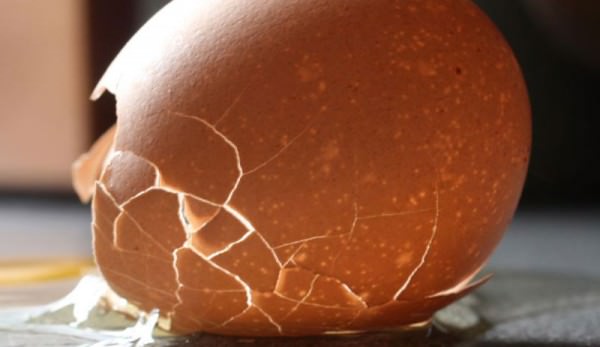
Inside the nest boxes, four brown eggs wait to be collected. Three of the four are nestled in wood shavings, the fourth looks like a wet mass; the egg’s insides are visible along with a flimsy film of shell. Laying an egg or two with a flimsy shell might occur as days get shorter in the fall and winter and young layers reach peak production. However, if you continue to see thin-shelled eggs, you need to examine the variables affecting a hen’s health.
Understand Shell Structure
An eggshell’s main ingredients are calcium carbonate, magnesium carbonate and calcium phosphate, as well as soluble and insoluble proteins. Ninety-five percent of the eggshell is calcium carbonate—the same sturdy substance that makes up coral, limestone and seashells.
It takes 2 grams of calcium carbonate for a backyard hen to form each egg. To come up with the necessary calcium each day, the hen borrows it directly from its own bones. Leg, wing and rib bones contribute the calcium without impacting its health.
An eggshell has an inner and outer membrane, a mammillary layer, a spongy layer and a cuticle layer that is finished with calcium carbonate, says Joe Regenstein, professor of food science at Cornell University.
“The porous nature of the egg allows for gas transport between the interior and exterior of the egg,” he says.
The eggshell can release carbon dioxide build-up inside while absorbing atmospheric air into the interior. At hatching, the air cell inside the egg is 15 percent of the egg’s volume, providing the first air the chick will breathe.
Regenstein explains that if the hen isn’t laying a structurally sound eggshell, its hormones, physiology and nutrition might not be working efficiently to support the egg-development process. If a hen isn’t consuming enough calcium in its for eggshell production, it may need more nutritional support.
Find Nutritional Balance
When a chick grows to egg-laying maturity, it’s time to switch from a grower feed to a layer feed. Layer feed has a higher level of calcium in it than a grower feed.
Most commercial feeds are going to be complete, says Andrew Brake, co-owner of Agrarian Urban Homestead and Supply, a retail gardening store in Indianapolis. However, just like some humans need more or less of certain nutrients in their diets, so do some chickens. Some hens won’t get enough calcium from layer feed and they will need a supplement to support healthy egg production.
Many people feed different types of greens—mustard greens, turnip greens, asparagus, okra, mushrooms, green beans and summer squash—and add in things such as buttermilk or clabbered milk.
Chickens will also eat banana, watermelon, strawberries and tomatoes. Because these birds like to eat, they will eat nearly anything. Free-range hens will also eat grass, insects, earthworms, grubs and whatever else they may scratch up from flowerbeds and lawns. This variety can be good, but it’s important to keep an eye on the consumption of the balanced feed diet. Just like some people who might choose to eat too many Hershey’s kisses, hens will select treats over the balanced diet provided by a feed.
Feed Nutritious Treats and Supplements
Oyster Shell
The traditional calcium supplement for a layer diet is oyster shells. Oyster shells look a bit like grit and are ground to the point that hens don’t have to work to eat them. Tom Tabler, an extension poultry professor at Mississippi State University, recommends putting out a separate dish of crushed oyster shell, which the chickens will eat it when they need calcium.
“If it’s available to them, the hens will consume enough to keep their own shells hard,” he says.
Rock Phosphate
Tabler notes that while phosphorus isn’t as big a deal as calcium, it’s also important and interrelated. Hens need a ratio of 1 part phosphorus to 2 parts calcium. You can purchase defluorinated rock phosphate in grit or powder form and put it out in a bowl for free-feeding just as you would oyster shell.
Crushed Eggshells
Crushed eggshells can also be fed back to hens in a separate bowl. Tabler recommends baking the eggshells for 30 minutes at 350 degrees F to draw out the moisture and kill any lingering bacteria. Once the moisture is gone, the shell will be easier to break down.
The risk of feeding eggshells back to the flock is that they may become egg eaters, breaking into and consuming their own eggs before they can be collected. By breaking the old shells into small unrecognizable bits discourages this behavior.
All of those options—from which complete feed to free-feed oyster and phosphorus to custom scratches and wholesome treats—help backyard chickens lay healthy eggs. At the same time, these practices give the backyard chicken-keeper the opportunity to create their own custom eggs supporting their nutrition while enjoying the antics of their hens.
Get more chicken-keeping help from HobbyFarms.com:
- 5 Steps to Get the Best Eggs Possible
- How to Start an Egg Business
- 7 Chickens to Raise for Colorful Eggs
- Sick Chickens? Spot the Symptoms [Infographic]
- 5 Ways to Make Coop-Cleaning Easier
About the Author: Deb Buehler is a professional writer who lives in Indianapolis, Ind., with her husband, two dogs and four hens. Watching the antics of backyard chickens is a favorite pastime for all members of the Buehler household.




